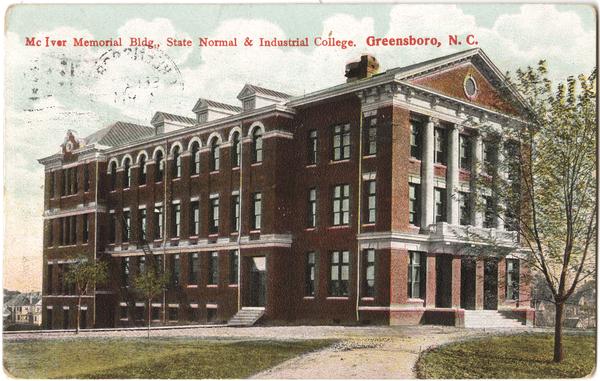After the Brick Dormitory fire of 1904, the State Normal and Industrial School (now UNCG) constructed Spencer Residence Hall to serve as the primary residence for students at the school. Once the site of the former Brick Dormitory had been cleared, however, administrators set to work on a much-needed classroom building for the growing school. Until this point, the overwhelming majority of the classes (as well as all of the laboratories and campus offices) met in the Main Building (now Foust Building). Enrollment had more than doubled in the 12 years since the school opened its doors for students. Class offerings had expanded, and the need for more instructional space was apparent.
Administrators initially envisioned a large classroom building with a central core and two wings, bigger overall than the Main Building which sat next door. The construction budget, however, restricted them to the central core only. And in May 1908, the McIver Memorial Building — named for the recently-deceased founding president of the school — opened for use.
The McIver Memorial Building quickly became the hub of instructional activity on campus and served as the primary home for chemistry and many of the other science departments and their laboratories. Additions were made to the building over the years. The McIver Statue (which currently sits in front of Jackson Library) was added to the front of the building in 1912. Also, as originally planned by administrators, two wings were added — an east wing in 1920 and a west wing in 1922.
But the building itself proved unsound rather quickly. By 1913, there were reports of faulty plastering in the building. As early as 1928, the central core of the building, then only 20 years old, was declared by Science Department head J.P. Givler to be both obsolete and a fire hazard. He referred to the electric wiring as “a patchwork of peril.” A small fire in 1932 was caught early and caused little damage to the building itself.
While most of the science departments left the McIver Memorial Building in 1940 after the construction of the Petty Science Building, McIver was still heavily used by other academic departments, particularly liberal arts departments. Yet, a 1950 report from state engineers proclaimed that, while the timber frame and brick veneer of the building were sound, the structure itself was at high risk of fire. They reported that it would cost more to fireproof the building than to replace it altogether.
The biggest blow to the McIver Memorial Building, however, came in February 1956 with a partial collapse of a plaster ceiling in Room 215, one of the heavily used classrooms. Luckily, at the time, no class was in session and no one was injured in the collapse. But an engineer who was called in to assess the structural damage recommended the closure of the third-floor of the building due to the plaster collapse. He noted that a large number of students in the building could cause a “considerable vibrational load” and might “increase the hazard of plaster crackings.”
Also, the building was once again labeled a fire hazard. “No Smoking Anywhere in McIver” signs were quickly posted around the building. Previously, instructors had been allowed to smoke in their offices and some allowed smoking in laboratories. The engineer’s report declared that “if a fire were to commence in the basement while a large number of classes were in progress, this department sees no way in the world that all students would be able to escape from the building before the open interior stairways had enabled the fire, smoke and other lethal fumes to engulf the entire building with the inevitable loss of many lives.”
Campus administrators were forced to close the building in July 1956 and reassign all classes to other building around campus. That same month, they met with state legislators to discuss funding for a replacement building, as the McIver Memorial Building had fallen to such a state that repair was much more costly than new construction. Administrators requested a building of “comparable size, on the present site of McIver and under the existing name.” Talks continued into Spring 1957, with students joining administrators in lobbying state politicians for funds for a new building.
The 1957 Legislature appropriated $1 million for a new building to replace McIver Memorial (campus leaders had initially asked for $1.3 million). In December 1957, a contract for demolition of the structure was awarded to W.W. Rike, Jr., of Winston-Salem, with a completion time limit of 120 days. By March 1958, the McIver Memorial Building was no more. And on October 5, 1960, the campus celebrated the dedication of the new McIver Building (which stands today) on the same site.
By Erin Lawrimore



